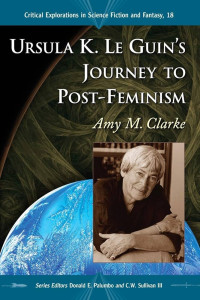 Joseph Thompson wrote this review.
Joseph Thompson wrote this review.
Learning about an artist is risky business. Near the end of my college career, I lost all respect for a musician I greatly admired after taking a senior seminar about that musician. The course confirmed what I already knew, that the musician was a genius, a prodigy even. But it added stuff I didn’t want to know: that the musician was also a near-pathological liar, total egomaniac, and borderline klepto. The kind of person who lies in chapter one of their autobiography and brags about it in chapter two. I’ve never been able to listen to that person’s albums with the same passion and abandon, and I even hesitate before describing them as an artist. In short, my personal feelings completely overcame my appreciation for the music.
So with great trepidation, I began reading Amy M. Clarke’s Ursula K. Le Guin’s Journey to Post-Feminism. So many things about this book scared me. By reading it, I faced the possibility of having another Dylan seminar experience. I deeply love Le Guin’s writing. Reading The Left Hand of Darkness I learned how science fiction can plumb the depths of human experience. Her Earthsea series taught me more about character growth and development than any course ever could. And her strong female characters in a hyper-masculine genre gave me the courage to include the rarest of characters in SF, non-stereotypical gay males. I did not know what I would do if I learned that somebody whom I’ve placed on the most precarious of pedestals may actually be a flawed human.
By the end of the preface, I grew to trust Clarke to lead me on this journey. She brings the reader to the beginning of her research, her 1992 dissertation “A Woman Writing: Feminist Awareness in Ursula K. Le Guin.” This starting point illuminates both the depths of Clarke’s exploration — much of it coming from directly interviewing Le Guin, herself — as well as Clarke’s realization that time has changed not only the concept of feminism but also Le Guin’s relationship to the movement.
The lengthy introduction continues this contextualization by exploring the feminist movement over time. Clarke carefully defines each wave, the various schools of theory within the movement, and its evolution. She defines her terms narrowly and lays out her argument in a pragmatic and logical manner. Her mix of personal and academic insight opens this complex discussion to both the lay and educated reader without becoming simplistic.
Labels create a unique challenge when examining through the lens of feminism and post-feminism. Unlike other theoretical schools, time and geography encouraged the evolution of disparate — if not contradictory — lines of thought. Basic questions about the construction of gender will receive different answers from first, second or third wave feminists, or American or French scholars. At different times, various writers have argued that equality should trend towards removing gender based differences, while others support recognition of each gender’s strengths.
Too often, academics treat this issue like a chess game. People are on one side of the board or another. They fail to take into account that the same changes experienced by the feminist movement also alter the whole of humanity. Clarke elegantly avoids this trap by acknowledging the static nature of the work — story X, published on date Y — along with the dynamic nature of the writer. “Though Le Guin describes her own beliefs as having always tended toward androgyny,” writes Clarke, “over the course of her long career she can be located at different points along this spectrum.”
Clarke poses three questions about Le Guin’s journey:
- If feminism had so changed Le Guin, where was the lasting evidence of this?
- Had she moved on from feminism?
- Had feminism itself moved on?
Over the course of four chronologically arranged chapters, she draws evidence from a wide array of sources to build a solid argument. Despite Clarke’s engaging voice, some points may feel abstract if the reader is not currently reading the Le Guin work cited. But this is not Clarke’s fault: relevancy is a shared duty between reader and author. Reading Le Guin’s stories at the same time will only serve to strengthen Clarke’s work. This holds most true in the fifth and final chapter. Clarke’s discussion about the contradictory impulses to subvert norms, without offending, works best with close analytical readings of the primary sources.
One other aspect of Le Guin’s journey needs comment: the notes. Nearly 20 percent of the book (sans index) is detailed chapter notes, an extensive bibliography, and an even more extensive secondary bibliography. They and Clarke’s writing are a testimony to her scholarship.
Now that I’ve finished this review, I have a letter to write to Le Guin. A thank you note. Rather than toppling a pedestal, Clarke has secured the base of a writer who is as nuanced and complex as the movement that defined much of her writing career.
(McFarland, 2010)
